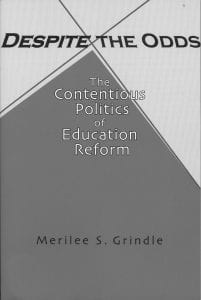A Review of Despite the Odds: The Contentious Politics of Education Reform
Process, Strategic Choice, and Success

Despite the Odds: The Contentious Politics of Education Reform By Merilee S. Grindle Princeton University Press, 2004, 257 pages
In the 1990s, education policy in Latin America cried out for reform. Although literacy rates and access to education in Latin America had risen in previous decades, education reform became part of broader political projects to modernize the economy and increase civil welfare.
In Despite the Odds: The Contentious Politics of Education Reform, Merilee S. Grindle uses five cases of education reform in Latin America to assess existing hypotheses about the success of education reforms. Grindle, Edward S. Mason Professor of International Development at Harvard’s Kennedy School of Government, counters the popular theory that successful reform is tied to economic patterns or related to electoral cycles and governing conditions. Despite the Oddsposits that policy makers concerned with education as part of broader political agendas give birth to reform initiatives and that the strategic choices both advocates and opponents make throughout the process of design, adoption, and implementation predict their long- term success and sustainability, even amidst contention.
Grindle’s focus on 1990s tries implemented controversial education reforms is distinctive. In previous decades education reforms had sought to increase access to education, while at the end of the millennium the salient goal was quality improvement. Enhancing education entailed an increase in accountability for management and utilization of resources; this implied the possibility of losing jobs and control over budgets and the certainty that the government would be responsible for more rather than less. Thus these reforms were contentious indeed. Implementing them necessitated more than perfunctory signatures on paper, but rather long processes of activities and decisions eventually affecting local classrooms. Since quality reform did not produce quick results, generating and maintaining public interest was a challenge. As Grindle explains, “the education reforms of the 1990s were so complex and politically contentious that it was reasonable to assume they would fail to be adopted, implemented and sustained.” Nevertheless, at least 12 Latin American couneducation policy changes in the 1990s. Despite mobilized opposition, bitter debates and resistant bureaucracies, politicians supported many unpopular initiatives. How can political theorists account for such reforms that succeed when the political cards are stacked against them?
“Clues to the conundrum of policy change despite the odds,” Grindle believes, “lie in an analysis of the political process of reform.” Her book focuses on the way in which reforms are introduced, designed, approved and implemented in an analysis of five education reform cases in Bolivia, Ecuador, Mexico, Nicaragua and the state of Minas Gerais, Brazil to explain how Latin American education reformers in the 1990s created conditions under which divisive education policies could be introduced and sustained.
Grindle’s choice of cases lends insight into particular types of education reform. In Minas Gerais, Nicaragua and Mexico reform was regarded as structural change that threatened the interests and influence of those with institutional power. The relatively successful implementation of these reforms dramatically altered the dynamics of decision making about education. Bolivia represents comprehensive reform that both updated power structures and focused seriously on pedagogy, including the unprecedented introduction of bilingual education. Grindle uses this case to explore how educational reforms can be brought to the classroom under considerable opposition. Ecuador’s attempts at education reform failed, and thus Grindle provides the example of “a counterpoint to the other cases in demonstrating some of the pathologies that inhibit education reform and in suggesting how reformers sometimes make strategic errors as they attempt to advance their visions of change.”
Despite the Odds offers a unique focus on five policy arenas in which institutions, interests and reformers strategically interact: agenda setting, design, adoption, implementation and sustainability. Grindle makes the interesting observation that the initial stages of reform represented an opportunity for reformers to limit the power of opponents, most notably unions, in preparation for the more public arenas of adoption, implementation and sustainability. She also identifies a trend in the emergence of new stakeholders and alliances as a result of the process of sustaining new initiatives.
Grindle’s treatment of the cases provides good evidence that neither political interests nor institutions fully account for policy reforms that occur despite political odds. Yet one limitation of her analysis is its small scope—five Latin American cases that occurred in the 90s—which leaves questions about the applicability of her results on a broader scale. Are the observations in Despite the Odds particular to time and place? Would a different set of Latin American countries in the 1990s have produced different results? To what extent can her observations be extended to other analyses of policy reform in the developing world? And how much can the lessons learned from education reform teach us about other social sector changes?
Grindle herself grants that other cases could have been chosen and encourages further study. Her focus on Latin America’s most recent education reforms contributes insights for the future. “I hope that by providing a general framework for understanding the politics of reform, others might be encouraged to test it using alternative experiences.”
Despite the Odds diverges from common political economy models that focus on institutions and interests as key players in the politics of reform and captures the factors that shape reforms and response to policy change. Grindle argues that “reform initiatives are dynamic political processes that unfold over time, as complex chains of decisions subject to interaction of proponents and opponents in institutional contexts sometimes subject to alteration.” Evidence from the five case studies proves this point, demonstrating, for example, how alliances among teachers’ unions and political parties in Latin America sometimes aided unions in obstructing change, but in other cases prevented them from acting against reforms.
Grindle emphasizes the fragility of reforms in her analysis of those most opposed to change, teachers’ unions. Despite the Odds takes on the complex topic of conflict between teachers’ unions and education reformers in Latin America. The dynamics of contestation over reforms in the five case studies lends to observation of divergent values and ideas about education and egalitarian participation among different tiers of Latin American society, where “the gulf between reformer and unions was wide and deep.” Reformers criticized union patronage, corruption and apathy towards improvements as the cause of education crisis. Union leaders decried poor salaries, the irrelevance and failure of past reforms, and their exclusion from reform dialogue. This conflict, Grindle argues, was critical to the fate of education reform in Latin America.
Grindle’s extensive look at the long-term outcomes of reform provides valuable insights into how new contentions emerged long after education reforms had been designed and agreed upon. Her findings also sound a warning about an uncertain future for education reform in Latin America if not enough heed is paid to union agency and if parents, teachers, administrators and politicians are not courted to the side of reforms.
Indeed, after the introduction of reforms, much contention was likely to play out in local government and school communities. Grindle emphasizes how reform policies have introduced new voices into public debates about education and makes an interesting case for the influence of grassroots support for reform: although Grindle’s examples reveal that specific education reform processes were elite projects emerging from centers of decision-making power, she also notes that the implementation of reforms meant everyday citizens could become more politically involved and express their opinions about the costs and benefits of change. Grindle’s analyses of reform in Bolivia, Ecuador, Mexico, Nicaragua and Minas Gerais challenge future reformers to find better means of engaging parents, teachers and communities in efforts to improve education quality. Grindle points out that in the wake of the political trend towards greater democratization in Latin America, involving the general population in the reform process could mitigate the disruption to the reform process caused by unrest over economic and social disparities.
Nevertheless, Despite the Odds does not present a definitive equation for successful education reform. Rather, this innovative work offers a theory of how reform outcomes are shaped, which Grindle dubs the “strategic choice approach”: the process through which reforms are designed, adopted, implemented and sustained and the strategic choices made by reform advocates and opponents. Her work reveals reform to be a fluid process in which sources of support and opportunity vary with each policy step and in which the choices reformers make at each point can potentially enhance or impede their success.Despite the Odds can be a useful tool for future reformers, as its lessons from the field about engaging citizen interest and garnering participation are pertinent to a new era of increased citizen demands for democratic accountability and more effective social services.
Spring/Summer 2005, Volume IV, Number 2
Eileen O’Connor, a former DRCLAS publications intern, studied Romance Languages and Literatures at Harvard College. She has taught high school Spanish and ESL to adult and children Latin American immigrants.
Related Articles
A Review of Default: The Landmark Court Battle over Argentina’s $100 Billion Debt Restructuring
In February 2019, I found myself serving as the special attorney general for the then newly recognized interim government of Venezuela, tasked with addressing more than 50 claims before the U.S. courts stemming from the $140 billion debt inherited from Hugo Chávez and Nicolás Maduro.
A Review of Until I Find You: Disappeared Children and Coercive Adoptions in Guatemala
A student in my “Introduction to Cultural Anthropology” course at the University of Delaware approached me several weeks ago, after hearing about my long-term research in Guatemalan communities, to tell me that they were born there, in Guatemala.
A Review of San Fernando: Última Parada, Viaje al crimen autorizado en Tamaulipas
One of Mexico’s best investigative journalists, Marcela Turati, takes readers to terrorized and traumatized San Fernando, a town known for dozens of mass graves, and exposes the depths of criminal brutality and official corruption that hid the bodies and the truth for years.




